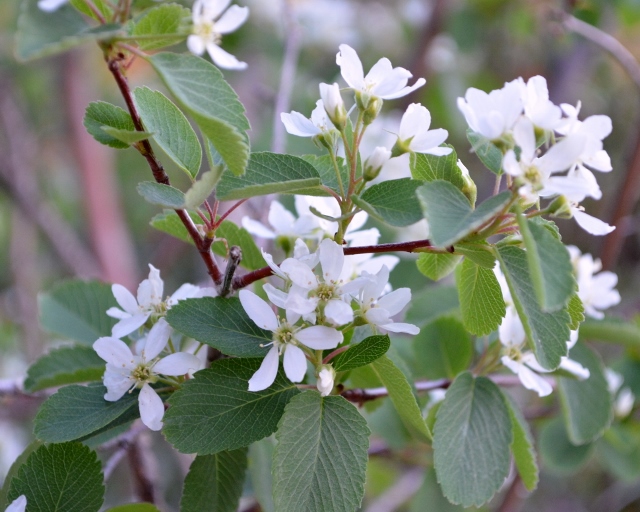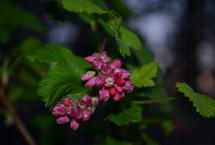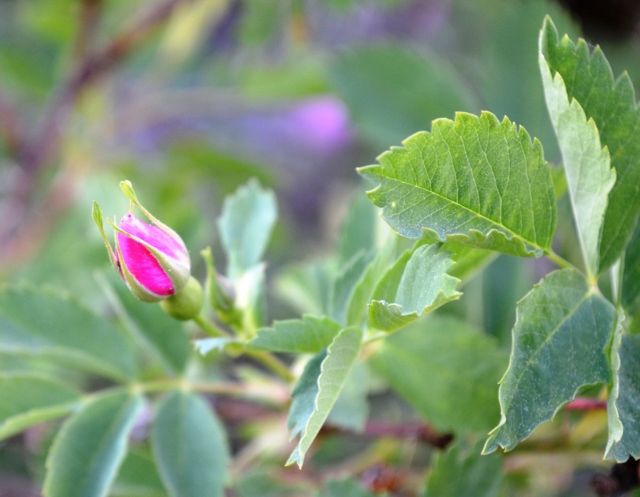saveourplanetearth.com
Call us: (775) 831-1331
Shrubs
I was doing my usual walk one morning, a route I’ve traveled at least 10,000 times, perhaps double that, and I noticed a tree up on the hill covered in white flowers. I almost couldn’t believe it as I had not ever noticed it before.
It has taken me two years and three hours of searching but I finally discovered it is a Western serviceberry, also known as Saskatoon, or Juneberry. Delicate star-shaped white flowers bloom in profusion in early spring on this native shrub that can grow 12 feet high and as wide.
In early summer, the blooms give way to purple berries which are edible and also nutritious, carrying calcium, iron, potassium, riboflavin, fiber and other nutrients. They look like blueberries, with a similar composition. The berries are popular in Canada; in fact, Canadian growers are currently trying to position the berries as a super fruit, in company with wild blueberries, cranberries, pomegranates and acai.
The serviceberry is a shrub in the rose family. The alternate, simple leaves are oval, nearly circular, and toothed with a single main vein and parallel branching veins. The leaf reminds me of the leaf of the wild rose and I spent some time while I was searching for its identity, trying to determine if it was perhaps some sort of wild rose without thorns.
I was to learn they are not even in the same family, however, I did learn about leaves and how important they are in the identification of a plant.
Things to look for are the veins in the leaf, the shape, if it has teeth or is smooth, if the leaves occur in groups, if they are alternating or across from one another.
A simple leaf is attached directly to the branch. A compound leaf is a group of leaflets, attached by a single stem to the branch. It’s helpful to have with you a reference book, such as “Sierra Nevada Tree Identifier”, which will take you through the steps of identification.
In the spring, new growth on the serviceberry is red, from which sprout the lovely white blossoms. Venture close to see its beauty, and it wouldn’t hurt to have a magnifying glass to fully absorb the intricacy of the blossoms.
Another deciduous plant that blooms from spring throughout the summer is the wild rose. Native to North America, including much of Canada and Alaska is the Rosa woodsii. So similar they look exactly alike to me, an amateur, is the Rosa californica, native to California, Oregon, the Sierra Nevada foothills and Baja California, Mexico.
Both grow as a bush or can form dense thickets, with prickly stems. The blooms open flat, with five petals in any shade of pink.
At this time of year, the blooms have given way to rose hips, which are eaten by birds and other animals, as they remain on the plant throughout the winter.
Rose hips can be eaten whole, can be boiled for tea or made into jam or even wine. They are high in vitamin C and contain other useful nutrients.
The rose hips contain the seed, which usually take several months to germinate and require a chilling period over the winter. Roses also reproduce when new shoots grow from the root crown or shoots can originate from a part of the root that contains a bud.
Another deciduous shrub with showy pink flowers which emerge early in the spring, is the Sierra currant. I first saw a specimen of this shrub several years ago when I happened to spy a spot of brilliant pink.
The flower is actually a cluster of small, bell-shaped flowers, as many as 20 in a cluster, hanging down like a pendant. They start out very pink, fading to pale pink, then white before the petals drop off and the plant begins producing its fruit which looks like a blueberry. In fact, I called it the blueberry plant until I discovered it in the handy reference, “The Laws Field Guide to the Sierra Nevada”, where I have been able to identify many of my “mystery plants”.
The leaves are a bright green, shaped like a maple leaf with teeth. This compact shrub grows to 3-6 feet and is native to California, Oregon and Nevada.
The show is mostly over for the season, but you can still keep a lookout for the rose hips, and perhaps a dried berry or two.
Western Serviceberry
Wild Rose
Rosa Californica or Rosa Woodsii
Sierra Currant





